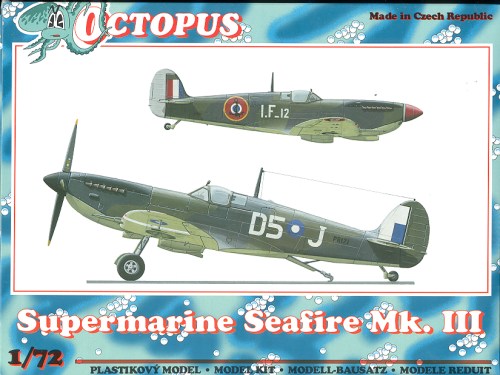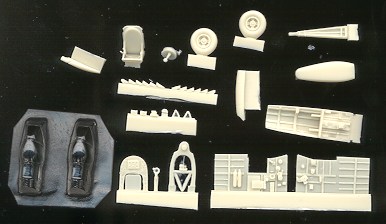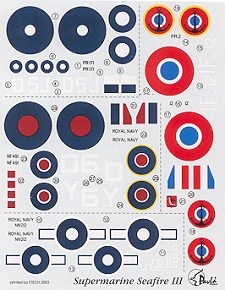
|
KIT: |
Ocopus 1/72 Seafire III |
|
KIT # |
72043 |
|
PRICE: |
$32.98 ($29.97 from Squadron) |
|
DECALS: |
Four options |
|
REVIEWER: |
Scott Van Aken |
|
NOTES: |
Short run with vac canopy and resin parts |

|
HISTORY |
Nowhere was this as obvious as with the Fleet Air Arm. It entered WWII with biplanes galore and what few monoplanes were developed, were not exactly world beaters when it came to being able to hold their own against land-based fighters. The result was that the FAA had to rely on converted land aircraft; first with the Hurricane and then with the Spitfire. Frankly, the Spitfire was not the plane that was needed aboard a carrier. The addition of carrier equipment and folding wings did little to enhance the flying performance of the plane. The narrow landing gear also meant that there were many accidents with the plane, however the need was great for something and so the Spitfire was modified into the Seafire, with reinforced bulkheads and all the accoutrements that were needed to allow life at sea.
The Seafire III arrived in squadron service in 1943. It had the folding wings needed and used the 'C' Wing with two cannon and four machine guns. In order to enhance low level performance, it was fitted with a four bladed prop to go along with its Merlin 55 engine. Though overshadowed by Lend Lease Martlets, Hellcats and Corsairs, the Seafire soldiered on where needed and some of the 1,250 aircraft built were sold to the French when they re-established their Naval air arm, and to the Irish Air Corps, who used de-navalized versions post-war.
|
THE KIT |

Once more into the realm of Czech short run kits. This one has very nicely done engraved detailing with some slightly overdone additions to the fuselage. Since the surface of the plastic is sandpaper rough, you can cut down some of the exaggerated work when smoothing out the plastic. There are the usual ejector pin towers on the large bits, but overall, this kit is well done. Some flash on some of the bits will also have to be removed, but other than the usual care with parts removal and clean-up, there should be no major problems. I am quite pleased to note that there are not four separate prop blades with this one and encourage Octopus/Pavla to do that with ALL their prop kits.
 Resin is used for the
majority of the detail parts and that means a super looking resin
cockpit. Removing all the small bits may be a bit of a challenge, but
they sure will look a lot nicer than any clunky injected styrene parts.
There are a few bits not used, like the large teardrop shaped bits and
the four smaller fairings that are obviously meant for some other variant
of this kit. The kit includes two vacuformed canopies that are not well
done as the clear plastic is rather distorted. I'd suggest pinching the
canopy from another kit or getting a replacement from Falcon (assuming
they do one in 1/72). Besides, you'll want to either open the canopy or
at least have a quality clear one to see all the work you've don
Resin is used for the
majority of the detail parts and that means a super looking resin
cockpit. Removing all the small bits may be a bit of a challenge, but
they sure will look a lot nicer than any clunky injected styrene parts.
There are a few bits not used, like the large teardrop shaped bits and
the four smaller fairings that are obviously meant for some other variant
of this kit. The kit includes two vacuformed canopies that are not well
done as the clear plastic is rather distorted. I'd suggest pinching the
canopy from another kit or getting a replacement from Falcon (assuming
they do one in 1/72). Besides, you'll want to either open the canopy or
at least have a quality clear one to see all the work you've don e
in the interior. By the way, the rear fuselage is already opened up for
you to install the arrestor hook and well.
e
in the interior. By the way, the rear fuselage is already opened up for
you to install the arrestor hook and well.
Instructions are as good as they get with a booklet showing all the pertinent construction steps. Color info is in generic, FS (where appropriate), Humbrol and Aga paints. Most of Pavla's instruction booklets give a lot of space to the color and decal options. This one is no exception. There are four different markings options; three FAA and one French Navy. All of them are in the Extra Dark Sea Grey/Dark Slate Grey over Sky color scheme. I should mention that the EDSG faded rather quickly to regular Dark Sea Grey so substituting that color would not be inappropriate. First aircraft has the barred SEAC insignia and was with 887 Sq aboard the HMS Indefatigable during the last days of the Pacific War. Next in the 'European' roundels is an 809 Sq Seafire aboard the HMS Stalker in 1944/45. The third FAA plane is with 807 Sq in the Far East during early '45 aboard the HMS Hunter. It has the large SEAC roundels on the wing and tiny ones on the fuselage. It also has the large, white SEAC bands on the wings and empennage. The French Navy version is with 1 Flotille as used in Indo-China during 1948 when aboard the Arromanches. As with all Pavla decals, they are well printed, colorful and probably very thin.
|
CONCLUSIONS |
Once more, the short run folks come to the rescue of modelers with a subject that is sure to please many. I've been informed that there is/was a High Planes kit and also a Czech resin one, but this one is probably the better of the three. If you have experience with short run kits, this one should be a breeze!
Late Note: I should have mentioned this earlier, but there is no real 'gull' to the lower aft wing. This very prominent feature is missing from this particular kit, and will undoubtedly hurt its sales. It is something that shouldn't have been overlooked.
If you would like your product reviewed fairly and quickly by a site that has nearly 250,000 visitors a month, please contact me or see other details in the Note to Contributors.